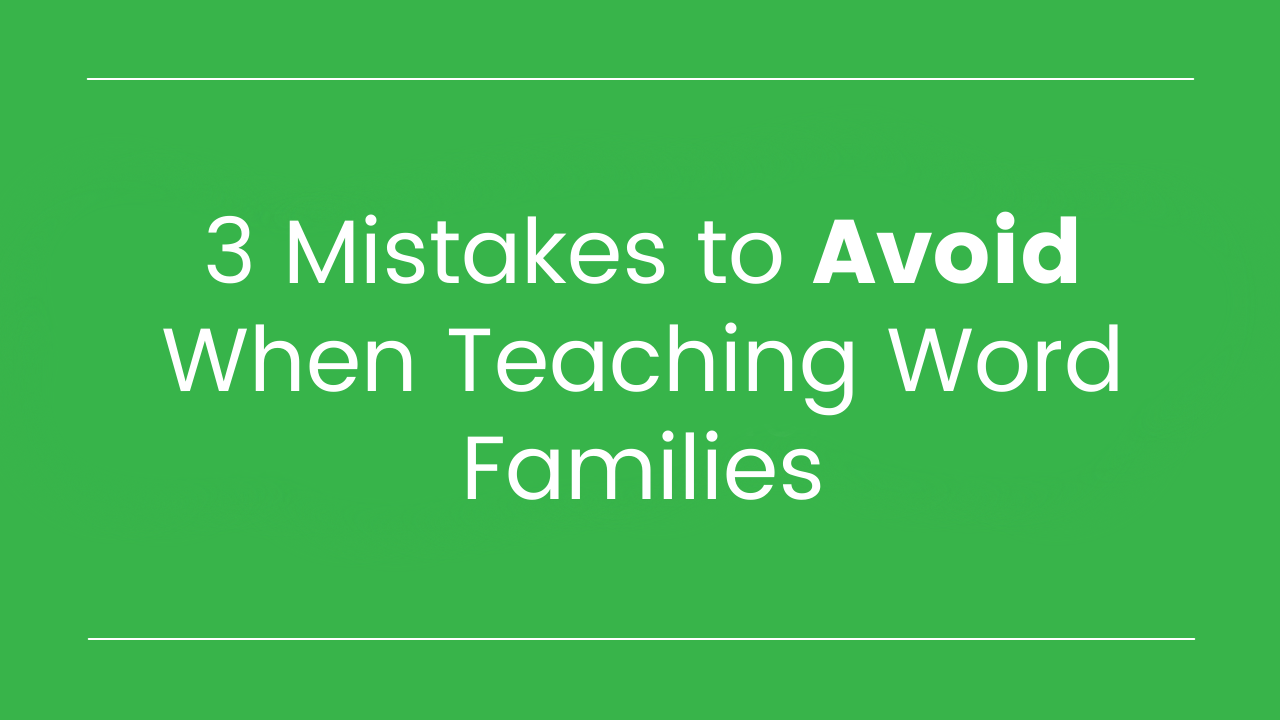
3 Mistakes to Avoid When Teaching Word Families
Looking to teach word families? In this post, we'll explore what word families are, why you would teach them, and 3 common mistakes to avoid. Let's dive in!
What are word families?
A word family is a group of words that have something in common with their spellings.
That "something in common" is typically the rime. The rime of a word is the vowel and any consonants that come after it in a syllable. For example, the rime in the word "street" is "eet."
Here are some examples of word families:
- "at" word family: cat, hat, mat, chat, flat, etc.
- "ike" word family: bike, like, hike, trike, etc.
- "oom" word family: room, doom, broom, etc.
Why teach word families?
There are TONS of words in the English language. Helping kids recognize patterns (like word families) can help them read and write more words than if we just taught words individually. Plus, the human brain loves patterns, so learning about word families can make it easier for many kids to learn words!
All of that said, traditional word family instruction has some flaws. So now we'll explore 3 common mistakes to avoid when you're teaching word families.
Mistake #1: Focusing more on teaching word families than on blending individual sounds (i.e. in CVC words).
Some reading programs, at least in the past, have gone straight to word families after students learn the sounds of the consonants and short vowels.
For example, students are asked to learn the word family "ad" and use that to read "had," "bad," "mad," etc. Students are encouraged to read the "ad" part as a whole. They say /h//ad/, instead of /h//a//d/.
Why is this a problem? Well, we can't skip over the fundamental skill of blending to read words, sound by sound, when teaching children to read. They must learn to read, for example - /h//a//d/, had - even though it may take longer and sound choppier. The vast majority of children won't achieve their full potential with reading and spelling if we don't give them plenty of practice with blending sound-by-sound.
Plus, it's just not necessary to have students memorize loads of word families. If they already know the letter sounds, let them use that knowledge to read words instead of asking them to memorize more patterns.
In From Sounds to Spelling, Kindergarten students learn the alphabet, and as they go, they practice reading CVC words with the sounds they're learning (with help). Later, they learn about different word family patterns like -at, -ig, -op, etc. However, the approach is more "Look at this interesting pattern" rather than "You need to use this pattern to read the words."
Mistake #2: Having students only read words in a list that have the same word family.
Helping students recognize patterns is great. However, we don't want to spend all of our time having them read words that are organized into lists for a single word family. We also want to make sure that we mix together different word families for reading practice.
For example, you might have students read the following list just once, if you want to discuss the "-ike" word family: hike, like, Mike, bike, spike
And then move on to lots of mixed long i word families: hide, time, hike, bribe, lime
This is helpful because if we rely on single word family lists (hike, like, Mike, etc.), students will likely look at the first sound in the word and then assume that the rest of the word sounds just like the other words. They aren't actually reading complete words!
You may have noticed this happening when a child successfully reads a list of word family words - but then can't decode one of the same words when it's in a text or in a different list of mixed words.
We want students to pay attention to all letters and sounds in a word when they're learning to read and spell!
Mistake #3: Not explicitly comparing and contrasting word families that sound the same.
This mistake is mostly related to teaching spelling (but of course, spelling helps with reading - it's all connected!).
Certain word families sound the same but are spelled differently. For example, let's take the word families "eat" and "eet."
- "eat" word examples: seat, meat, heat, treat
- "eet" word examples: meet, feet, beet, greet
In From Sounds to Spelling, we focus more on the spelling patterns of "ea" and "ee," rather than "eat" and "eet." Students have opportunities to compare and contrast words with these patterns. Word sorts are a great way to do this!
Comparing and contrasting spelling patterns helps students acquire specific word knowledge so that they know, for example, that "heat" is spelled with "ea" instead of "ee."
Do I even need to teach word families?
By now, you might be thinking, wow - there are a lot of pitfalls to avoid here! Should I even teach word families at all?
The truth is that teaching students about patterns in words is important, but spending tons of time working on specific word families just isn't necessary.
Our phonics program, From Sounds to Spelling, shows you exactly how to teach students about the patterns in words without over-focusing on word families. To receive a free week of instruction for Kindergarten, first grade, and/or second grade, click here!





